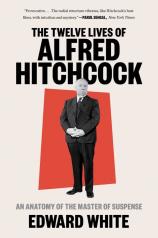The Twelve Lives of Alfred Hitchcock: An Anatomy of the Master of Suspense
Review
The Twelve Lives of Alfred Hitchcock: An Anatomy of the Master of Suspense
Every few years, it seems that a new biography comes out about a celebrity that alters the perception long held by fans and even peers. THE TWELVE LIVES OF ALFRED HITCHCOCK falls into this category.
Edward White, author of THE TASTEMAKER: Carl Van Vechten and the Birth of Modern America, “dissects” Hitchcock into what could be considered multiple personalities, each one supposedly contributing to his genius (although when reading some passages, one might call the legendary director an evil genius).
We have seen some of the material within White’s overview before: Hitchcock’s obsession with blondes; his “voyeurism”; his legacy as a pioneer and auteur; the way he (mis)treated his actors, especially the women; and his childhood fear of police and authority. But what is especially interesting are chapters covering his attitudes regarding style and fashion, religion, and even his own weight issues.
"THE TWELVE LIVES OF ALFRED HITCHCOCK makes a worthy addition to the cinephile’s library and undoubtedly will appeal to Hitchcock devotees."
Hitchcock was probably no better or worse than many of his contemporaries. He could be petulant, sarcastic and downright mean, but he was also a staunch family man and willing to take chances where others wouldn’t. I’m sure some of his performers and crew members could tell stories about perceived abuse, pettiness and jealousy, which was all part of the game. So in that regard, was Hitchcock more of a bad egg because he didn’t like to share the spotlight or credit with others (save his beloved wife, Alma)? Was he especially harsh on his actresses, like Tippi Hedren, Kim Novak and Grace Kelly?
The chapter “The Dandy” was especially entertaining and illuminating as we learn about the attention to detail taken when it came to wardrobe and set furnishings. Describing the elegant designs for Rope, which was set in New York and was one of Hitchcock's more technically original (if not box-office successful) films, White writes, “It was a material existence that Hitchcock understood, for it mirrored his own. It was he who guided the selection of the artworks to be hung on the apartment walls; he who stipulated the color of [the actors’] suits. Despite looking like a staid British bank manager, Hitchcock apportioned great depth to the surface of things. He wasn’t showy or decorative in his dress, but he was committed to the perfection of appearance as a way of exerting control over himself and the world around him.”
White doesn’t get into the nitty-gritty about Hitchcock’s filmography as Francois Truffaut did in HITCHCOCK. But it’s just this type of inspection that sets his book apart from previous examinations.
However, this is not a perfect book by any means. Some readers might look askance as the author seems to take a certain pleasure in pointing out Hitchcock’s not insubstantial faults, although those looking for gossipy tidbits might enjoy such disclosures. Similarly, there is a haughty film studies feeling in spots where White might discuss aspects of the movies beyond the casual fan’s education.
Overall, though, THE TWELVE LIVES OF ALFRED HITCHCOCK makes a worthy addition to the cinephile’s library and undoubtedly will appeal to Hitchcock devotees.
Reviewed by Ron Kaplan on April 23, 2021
The Twelve Lives of Alfred Hitchcock: An Anatomy of the Master of Suspense
- Publication Date: June 7, 2022
- Genres: Biography, Nonfiction, Performing Arts
- Paperback: 400 pages
- Publisher: W. W. Norton & Company
- ISBN-10: 1324022124
- ISBN-13: 9781324022121




